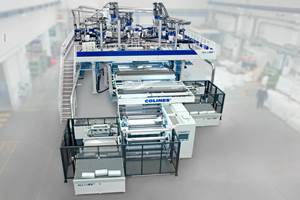Flexible-Film Processor Optimizes All-PE Food Packaging
Tobe Packaging’s breakthrough was to create its Ecolefin PE multilayer film that could be applied with a specialized barrier coating.

Exceed S mLLDPE is a major part of the Ecolefin all-PE structure as is Aegis’s OX2 barrier coating. Photo Credit: ExxonMobil Chemical and Tobe Packaging
Within the last two years, Singapore’s Tobe Packaging aimed to develop an all-PE multilayer film structure for food packaging that would not fall short in offering the same kind of protective barrier of multimaterial food packaging, and would be much easier to recycle.
The film processor’s breakthrough was an all-PE structure to which a specialized barrier coating can be applied. In August 2022, the company’s Ecolefin was certified as 97% recyclable by Germany-based Institute cyclos-HTP, one of Europe’s leading and recognized organizations for recyclability testing and certification. A month later, when Tobe launched Ecolefin at the international FHA-Food & Beverage Exhibition, interest was sparked from multinational food companies from the United States, South Korea, Switzerland, Spain and Australia.
All this is thanks to its close collaborations with ExxonMobil Chemical, and its specialized PE film resins, most notably its new Exceed S mLLDPE, and Singapore’s Aegis Packaging, which developed and supplied a specialized O2X barrier coating. The development was headed by Tobe packaging director Lim Zie Hui, whose father established packaging business Lension in 1976, and acquired Tobe in 2019.
Founded in 1987 as a manufacturer of custom PE and PP bags, Tobe branched into flexible packaging in the late ’90s adding more variety of packaging pouches and multilayer packaging for food (including pet food) as well as nonfood packaging such as medical, semiconductor and hygiene products.
Tobe, which has now expanded its products and services beyond Southern Asia to places like Sri Lanka, currently has blown film extruders, printing machines, lamination machines, slitting and bag making machines. Before the end of 2023, the company will be installing two new machines: a printing machine which can operate using water-based ink (as it is more environmentally friendly) and a new coating machine.
Says Lim, “Exceed S is a major part in the Ecolefin solution, which provides balanced stiffness and toughness of full PE-laminated structure. Aside from Exceed S, we also utilize the Exceed series mLLDPE to enhance the film sealing performance and the Enable series mLLDPE to improve the film stiffness.”

Tobe Packaging is initially using Ecolefin for frozen food, chilled food and vacuum packaging, but is aiming to “tweak the material’s formula” to better suite different products such as easy-to-open snack packaging.
Ecolefin is said to be well suited for frozen food, chilled food and rice packaging. Ecolefin is used to replace the incumbent multilayer laminated structure, particularly nylon and PE laminated film — more specifically, nylon 6 used as a barrier and LDPE used as sealant. The O2X barrier coating developed by Aegis is applied on the film, and Tobe has invested in its own specialized coating machine which will be commissioned by fourth quarter 2023.
Better Oxygen Barrier
Ecolefin’s oxygen barrier is about eight times better than that of the previous film structures. This translates to longer shelf life for food packaged in Ecolefin. Tobe is currently using a third party laboratory to conduct tests to determine how long the material can prolong the shelf life of different food products.
According to Lim, Ecolefin is 10% to 15% higher in cost than nylon 6/LDPE alternative. However, considering the sustainability advantage it offers, Ecolefin presents the opportunity to achieve multiple benefits. With its ability to be sealed at lower temperature, customers can save on electricity consumption and contribute to reducing their carbon footprint. In addition, its monomaterial composition facilitates convenient recycling, further enhancing its eco-friendly attributes.
Tobe is also aiming to design other packaging options, including stand-up pouches, and to “tweak the material’s formula” to better suit different products, such as snack packaging that is easier to open. As it moves ahead with Ecolefin, the company is exploring how to further its sustainability efforts and bottom line, including the recycling of food packaging into products such as trash bags, by working with supermarkets and third-party collectors.
Related Content
Best Methods of Molding Undercuts
Producing plastics parts with undercuts presents distinct challenges for molders.
Read MoreHow to Optimize Injection Molding of PHA and PHA/PLA Blends
Here are processing guidelines aimed at both getting the PHA resin into the process without degrading it, and reducing residence time at melt temperatures.
Read MoreYoung Stretch-Film Processor Bets on Nanolayers
Going up against companies with as much as double its capacity, young stretch-film processor Zummit believes that new technology — notably 59-nanolayer films — will give it a competitive edge.
Read MorePregis Performance Flexibles: In the ‘Wow’ Business
Pregis went big and bold with investment in a brand-new, state-of-the-art plant and spent big on expanding an existing facility. High-tech lines, well-known leadership and a commitment to sustainability are bringing the “wow” factor to blown film.
Read MoreRead Next
How Polymer Melts in Single-Screw Extruders
Understanding how polymer melts in a single-screw extruder could help you optimize your screw design to eliminate defect-causing solid polymer fragments.
Read MoreWhy (and What) You Need to Dry
Other than polyolefins, almost every other polymer exhibits some level of polarity and therefore can absorb a certain amount of moisture from the atmosphere. Here’s a look at some of these materials, and what needs to be done to dry them.
Read MoreProcessor Turns to AI to Help Keep Machines Humming
At captive processor McConkey, a new generation of artificial intelligence models, highlighted by ChatGPT, is helping it wade through the shortage of skilled labor and keep its production lines churning out good parts.
Read More


























